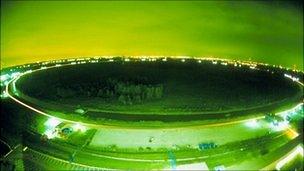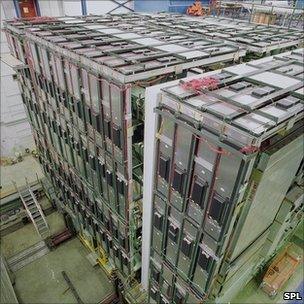Tests 'reject new particle claim'
- Published

The Tevatron was, until the advent of the LHC, the highest-energy accelerator in the world
Cross-checks on data that hinted at the discovery of a new sub-atomic particle have failed to find support for the observation.
In May, researchers working on the CDF experiment at the US Tevatron "atom smasher" announced they had detected tantalising hints, external of an unanticipated particle.
But independent checks using a separate experiment called DZero have not been able to corroborate the findings - dealing a blow to the idea.
A confirmation would have heralded one of the most radical changes to physics in years.
The DZero result comes several days after a CDF team member presented updated results showing the signal had strengthened - not disappeared - after analysing about double the amount of data.
Scientists from both Tevatron experiments will now have to "compare notes" with the aim of reaching a consensus.
The Tevatron is the only major competition to Europe's Large Hadron Collider machine. It is operated by the Fermi National Accelerator Laboratory (Fermilab), based in Batavia, Illinois.
Independent working
The independent check by DZero is revealed in a seminar at Fermilab on Friday. A paper describing the findings, external is set to be published on the Arxiv repository, and has been submitted to the Physical Review Letters journal for review.
Professor Stefan Soldner-Rembold, spokesperson for the DZero collaboration, told BBC News: "We looked at the data-set that CDF originally published... We inject a signal in our simulation which looks like what we would have observed if CDF had seen the real thing.
"We analysed the data accordingly and, as observed, there is no enhancement. We can exclude something like what CDF observed to a relatively high probability."
Dr Giovanni Punzi, co-spokesperson for the CDF collaboration at Fermilab, told BBC News: "It has taken a step forward and a step back. But [DZero] has used only half of the data we currently have. So they are now showing a result with our old sample size."
When BBC News spoke to Dr Punzi, who is from the University of Pisa, Italy, he was responding to rumours that DZero had seen a "smaller excess" and had not yet seen DZero's results.
The CDF team was analysing data from collisions between protons and their anti-matter counterparts antiprotons. In these collisions, particles known as W bosons are produced, along with a pair of "jets" of other particles.
It was in these jets that the unexpected "bump" in the team's data came to light, potentially representing a particle that the widely accepted theory of particle physics - known as the Standard Model - does not anticipate.
As such, confirmation of the CDF results would have signalled a radical change in physics. But researchers stress the finding is definitely not the elusive Higgs boson - which explains why other particles have mass. The Higgs is the last missing "jigsaw piece" needed to complete the Standard Model.

DZero is a multi-purpose detector based at the Tevatron facility
When CDF's result was first announced, it was said to be at the "three sigma" level of certainty. This means there is roughly a 1 in 1,000 chance that the result is attributable to some statistical fluctuation in the data.
At a conference at Blois, France, on 30 May, Dr Punzi, announced that after analysing much more data, external, the "excess" was just below a five sigma level of certainty.
Five sigma means there is about a one-in-one-million chance that the "bump" is just a fluke and is the level generally required for a formal discovery.
Theorists have already weighed in on the CDF data peak. According to one school of thought, it could have provided support for a fifth fundamental force of nature known as "technicolour".
Technicolour is similar to the "strong force", which binds particles known as quarks together inside the nuclei of atoms. It could also give particles their mass - making the Higgs boson unnecessary.
Top stuff?
Other researchers suggested an effect called "top background", external could explain away the "bump" seen by CDF.
They suggested that researchers might have underestimated the number of top quarks - an elementary heavy particle - being produced at the Tevatron and that this could have yielded the data peak, external. But Dr Punzi said this idea had now been tested and ruled out.
Professor Soldner-Rembold, from the University of Manchester, UK, explained: "This is why it is good to have two experiments [at the Tevatron].
"What we see here is the scientific process at work. If one experiment sees something, another one has to verify it, and currently, we cannot verify it."
US Department of Energy budget cuts are forcing the Tevatron to shut in September this year; by the time the machine accelerates its last particles, it will have been operating for some 28 years.
The decision to close the facility was taken despite the recommendations of a scientific panel that the Tevatron's lifetime be extended by three years in order to continue hunting for the Higgs boson.
Paul.Rincon-INTERNET@bbc.co.uk
- Published7 April 2011
- Published10 January 2011
- Published26 October 2010
- Published3 November 2010
- Published1 February 2011